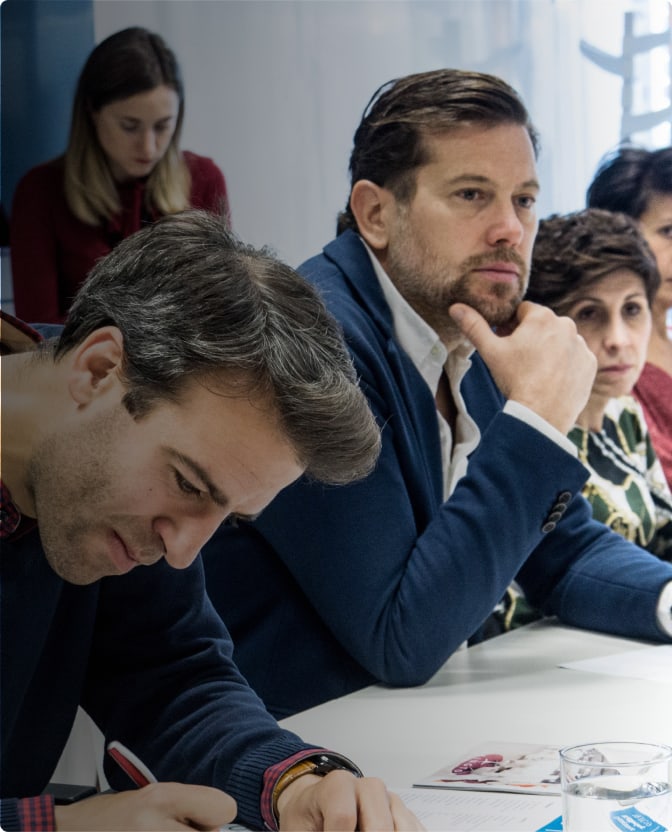New job roles and new challenges for C-level executives

Marta Gómez
Here you’ll find bespoke workspaces in the top locations in Madrid and Barcelona. Flexible offices that combine private and shared spaces, collaborative areas and meeting rooms. Always in premium, corporate surroundings.
Furnished offices, fully customizable to your needs
Equipped meeting rooms for hourly or daily use
Themed lunches, special days, and events to connect and share
Online community to collaborate from anywhere
Shared spaces to relax and socialize
24/7 access and security—work whenever you want
Free coffee, every day, anytime
Ultra-fast and reliable Wi-Fi




Paseo de la Castellana, 79. Floors 5, 6, 7 and 8. 28046 - Madrid

Príncipe de Vergara Street, 132. Floors 4, 9 and 12. 28002 - Madrid

Jorge Juan Street, 35. 28001 - Madrid

Paseo de la Castellana, 141. 18th and 19th floor. Edificio Cuzco IV. 28046 - Madrid

Calendula Street, 93. Building E, Miniparc III. 28109 - Alcobendas


Avenida Diagonal, 545. Floors 4 and 5. 08029 - Barcelona


Paseo de la Castellana, 79. Floors 5, 6, 7 and 8. 28046 - Madrid

Príncipe de Vergara Street, 132. Floors 4, 9 and 12. 28002 - Madrid

Jorge Juan Street, 35. 28001 - Madrid

Paseo de la Castellana, 141. 18th and 19th floor. Edificio Cuzco IV. 28046 - Madrid

Calendula Street, 93. Building E, Miniparc III. 28109 - Alcobendas


Avenida Diagonal, 545. Floors 4 and 5. 08029 - Barcelona





Jorge Juan Street, 35. 28001 - Madrid
Paseo de la Castellana, 141. 18th and 19th floor. Edificio Cuzco IV. 28046 - Madrid
Paseo de la Castellana, 79. Floors 5, 6, 7 and 8. 28046 - Madrid
Príncipe de Vergara Street, 132. Floors 4, 9 and 12. 28002 - Madrid
Paseo de la Castellana, 141. 18th and 19th floor. Edificio Cuzco IV. 28046 - Madrid


Meetings
Team meeting in our Amelia Earhart Room
Jorge Juan Street, 35. 28001 - Madrid


Training sessions
More Quota training day at the Minnesota Room
Paseo de la Castellana, 141. 18th and 19th floor. Edificio Cuzco IV. 28046 - Madrid


Events
Team Building Event in our Michigan Room
Paseo de la Castellana, 79. Floors 5, 6, 7 and 8. 28046 - Madrid


Conferences
My healthy company in our Vivaldi Room
Príncipe de Vergara Street, 132. Floors 4, 9 and 12. 28002 - Madrid


Boards
Wellbeing meetings in our Minnesota Room
Paseo de la Castellana, 141. 18th and 19th floor. Edificio Cuzco IV. 28046 - Madrid





Our real examples will show you how we generate value for companies
The British cybersecurity company boosts its presence in the Spanish market with a fully bespoke workspace.
Workspaces in the financial heart of Madrid for growth and continuous adaptation to the needs of the CM team.

The leadership consultancy firm is committed to Lexington’s corporate coworking formula.

Bespoke spaces with flexible conditions for business models undergoing constant growth and change.

A leading US multinational chose this space at Lexington for its new office in Madrid.




Get up to date with flex
Subscribe to our newsletter to make sure you don't miss anything. On trend content you’ll be interested in.
Contact us
Request information
Solicitar información free pass
Request a quote
Visit our spaces
Trabaja con nosotros
Contact us
Work in a flexible space.
Optimize on costs compared to a conventional office
Estimation of costs compared to conventional office hire
0 people Office for
Select
5 people
10 people
15 people
25 people
Select a number of people and we’ll show you the expenses included in our flexible office hire.
Conventional office
Operational costs and supply costs:
€/month
+ opening expenses
Flexible office
Operational costs and supply costs:
Included
No opening expenses
Included in the monthly bill
€517.01/person
0€
2.264,24 €/person
0€
523,69 €/person
0€
Guarantee bond
6 months
Deposit
2 months
Since
12 months
Since
1 month
2-6 months
2 months
Request a quote





